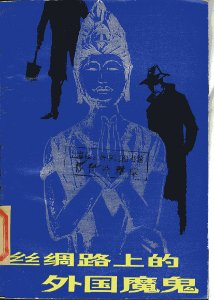Foreign Devils on the Silk Road (1982)
Foreign Devils on the Silk Road (1982)
Peter Hopkirk (1982): Sichoulu shang de waiguo mogui 丝绸路上的外国魔鬼. Lanzhou: Gansu renmin chubanshe.
This book is a translation of Peter Hopkirk’s book Foreign Devils on the Silk Road: The Search for the Lost Cities and Treasures of Chinese Central Asia (1980). Hopkirk (1930-2014), a British journalist who had traveled widely through Central Asia, India and China, describes in it the rediscovery of the Silk Road by scholars and adventurers in the beginning of the 20th century, amongst them Sven Hedin, Aurel Stein, Paul Pelliot and Langdon Warner (the latter became one of the models for Steven Spielberg’s Indiana Jones). It is one of the first books that sees the acquisition of cultural artifacts by European archeologist and travelers critically, pointing out that men like Stein and Pelliot have robbed China of its cultural treasures, hauling them to Europe by the tons, thereby also contributing to the arrogance of Western civilization, or as John Dewey put it in his 1934 work Art as Experience: “Most European museums are, among other things, memorials of the rise of nationalism and imperialism.” Nowadays these artifacts from Central Asia — especially from Dunhuang — are scattered in museums and collections all over the world, a fact that has deeply been resented given the recent calls for restitution.
Hopkirk explains in the preface that the writing of this book has profited from professor Xia Nai’s 夏鼐 support, then director of the Archaeological Institute in Beijing. Xia (1919-1985) was an archaeologist who received his PhD of egyptology in 1946 at the University College London and was also a corresponding member of the British Academy. In 1944 he took up his work at the Department of Archaeology at the Institute of History and Philology at Academia Sinica (1943-1949), becoming its director in 1948. When the Academia Sinica moved to Taiwan after the Civil War, Xia stayed in China and became a member of the Chinese Academy of Sciences. According to his diary, Xia credited Aurel Stein with many significant archeological insights as described in the work On Ancient Central Asian Tracks (Stein’s summary of three expeditions to Central Asia), yet saw the attitude and behavior towards China’s national treasures critically.
What is special about this book is not only the cooperation between a Chinese scholar and a foreign writer, but also the fact, that it has been translated into Chinese quite quickly, namely almost within one year of its publication. The critical and accusatory description of the raids conducted by the European imperialists give the book – especially in the Chinese preface – a political character, which comes along with the reaffirmation of Chinese cultural heritage at a time when culture (and later patriotism) more and more replaced the socialist ideology. It is interesting to observe in this context that the term „Foreign Devils“ is absent in the German translation, yet is probably one reason for translating the book at all. Given the fact that Hopkirk thanks Xia Nai for his support when doing archival research for this book in Beijing and speaks for the Chinese might imply him being a victim of propaganda, but reading the book at length shows that the author shares the Chinese feeling of humiliation and calls for rightful restitution of cultural artifacts, a call that in the past few years has been on the rise due to the growing sentiment of patriotism in Chinese society. When in 2009 Cai Mingchao 蔡銘超, an advisor to China’s National Treasures Fund, bid successfully at the auction of two Old Summer Palace bronze heads that had been looted during the Second Opium War in 1860 — in Chinese modern history an event of national humiliation — he reiterates Hopkirk’s view, which shows that the call for repatriation of cultural relics is not simply a result of rising Chinese patriotism, but a global concern that is — especially after the Orientalist critique — no longer a call issued from the colonized solely.
Marc Matten
